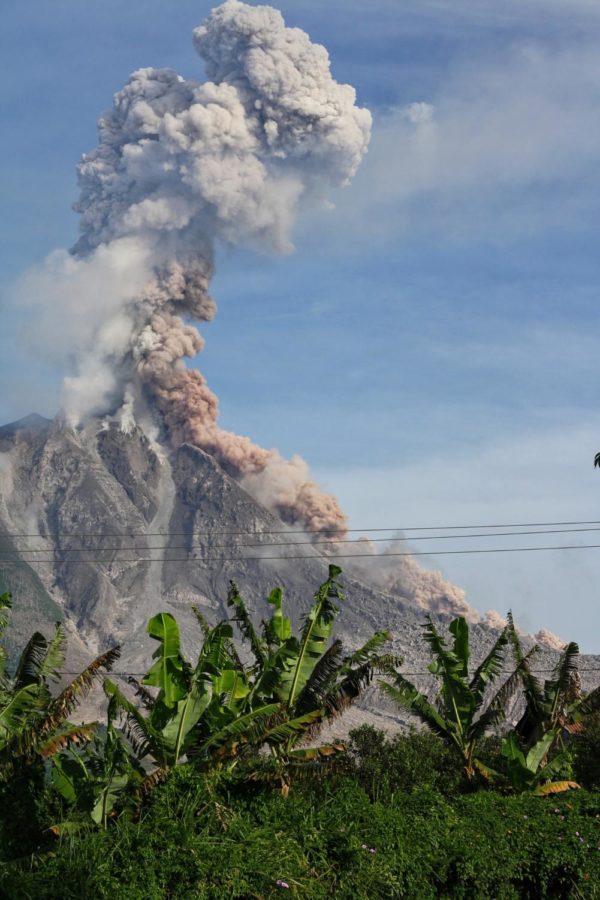Canary Islands Volcano erupts for the first time in 50 years
The island of La Palma is part of the Spanish Canary Islands and is one of the most volcanically active zones in the archipelago, however, it erupted for the first time in 50 years on Sept. 19. About 90,000 people call the island home.
On Sept. 19 at 3:12 p.m. La Cumbre Vieja volcano on the Canary Island of La Palma in Spain erupted with lava covering 2,300 feet per hour, moving toward the ocean. The eruption is the Canary Islands’ first volcanic eruption on land in 50 years, and had the need to evacuate more than 6,000 people from the affected areas.
The Cumbre Vieja volcano on the Canary Island of La Palma in Spain has occasionally shuddered, rumbled, and grumbled, but no lava has emerged since 1971. But this weekend, on Sept. 19 at 3:12 p.m., local time, that changed. Rising vertiginous fountains of magma tore open several fissures on its Western flanks, and an extravagant eruption began measuring up to 2,000 degrees Fahrenheit. The regional government said that they expect no more injuries, after some 6,000 were evacuated, but Spain’s Civil Guard said that it could need to evacuate up to 10,000 residents in total.
On Sept. 11, an earthquake swarm began rocking the volcano, foreshadowing a possible development to arrive. Authorities issued a yellow alert for part of the island on Sept. 13, the second-highest tier of advisory that can be issued for an expected eruption. According to Spanish newspaper El País, about 35,000 people were included in the alert.
According to the Canary Islands Volcanology Institute, lava was flowing on the island of La Palma toward the sea, moving at 2,300 feet per hour. People at La Palma rely on farming as their main source of economy, and this eruption, which is estimated to last weeks, if not months, can interfere with such. However, the lava is not expected to cover the entire island and touch the almost ninety-thousand habitants, as it is assumed that it should reach the waters promptly.
Huge red plumes topped with black-and-white smoke shot out along the Cumbre Vieja volcanic ridge, which scientists had been closely watching following the accumulation of molten lava below the surface and days of small earthquakes. The last eruption in la Plama lasted over three weeks, and the last eruption on all the Canary Islands occurred underwater off the coast of El Hierro island in 2011, which lasted five months.
“Based on satellite observations of SO2, so far most of the SO2 emissions from La Palma have remained in the vicinity of the Canary Islands and the island of Madeira to the north,” wrote Simon Carn, a volcanologist at Michigan Tech, in an email. “We might expect some local impacts such as haze, poor air quality and perhaps acid rain on La Palma or neighboring islands.”
Spain’s National Geographic Institute outlines several risks, including toxic gases and lava flows, which have already swallowed up local houses, infrastructure and crops on the Canary Island. Juan Acosta Rodríguez, a local of Las Indias neighborhood in La Palma, was the only official victim of the eruption at Teneguía on Oct. 26, 1971, and photographer Heriberto Felipe Hernández, from Santa Cruz de La Palma, who died in hospital with poisoning symptoms after going to the affected area on several excursions. Both were victims of one of the main dangers identified by Spain’s National Geographic Institute following a volcanic eruption: lava flows, ash, pyroclastic flow, gas emission, lahars, landslides and tsunamis. Flank collapses of volcanoes are a genuine concern, and it’s true that several flank collapses on La Palma’s shores took place many thousands of years ago. But a study from 2015 found that under realistic modeling conditions, the most severe collapse could cause no more than a six-foot tsunami along Western Atlantic coastlines.
As was mentioned, eruptions on La Palma can last from a few weeks to several months. “The only way to know is to know the total volume of eruptible magma under Cumbre Vieja,” says Pablo J. González, a physical volcanologist at the Spanish National Research Council on Tenerife. “That piece of information is unknown.”
Because the Spanish experts are actively monitoring the progression of the volcano, the residents of La Palma are being protected by a vanguard of volcanologists and a shield of seismologists. The long-term efforts by geoscientists on the island ensured that it was clear that something iniquitous was brewing long before serpentine lava flows crept out of Cumbre Vieja’s hillside this Sunday. Now, the authorities are joining forces to protect and keep the citizens of La Palma safe.
“The evacuation of people is the main priority … although there are also other important tasks such as keeping pets safe,” the Guardia Civil tweeted, with a video showing officers carrying reluctant goats to safety.

